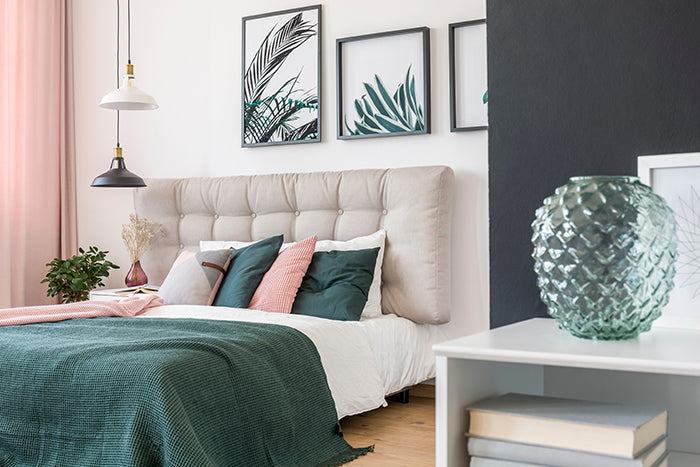In a home, lighting makes all the difference. It impacts the atmosphere, the mood, the comfort and even the colour of the walls!
If you wish to play with your lighting intensity, dimmers are necessary. As LEDs are gaining popularity and replacing regular bulbs in our homes, you need to shift towards adaptive-phase dimmers. Otherwise, you may experience light flickering and hear a crackling noise when the lighting is at its lowest intensity, and that may sweep away the beautiful decor you’ve pulled together.
As for lighting in general, we’ve asked experts what were their best advice to bring more light so you can enjoy every room no matter the time of the day.
Q: How to add light to a dark room?
It is always best to consider more than one source of light for any room, especially in a dark room. For overall general lighting, pot lights are still popular, and with LEDs, you have options on your preferred colour of light. Always set these on a dimmer for versatility. Wall sconces add beautiful light up and down a wall and can be paired easily with the simplicity of pot lights. And lastly, add floor or table lamps with white shades so that they too can add brightness in more specific task areas, like reading by a chair. To sum it up – layer your lights and you’ll always have the right amount of light for the right time of day, even in rooms missing natural sunlight.
Susan Abramson, Toronto Designers
Q: What type of lighting should be used in a bedroom?
In a bedroom, we like to play with two types of lighting. Either general lighting when you want to have sufficient lighting for bedroom cleaning chores or to choose your clothes and auxiliary lighting to have a more relaxed atmosphere that leads to sleep. As general lighting, you can use flush mount lighting
or a suspension if the room allows it. Using pot lights can also provide excellent general lighting in the room. For extra lighting, we suggest table lamps placed on the bedside table or the use of small pendant lights or wall sconces placed on each side of the bed. Note that the examples mentioned are only suggestions, as there is a great variety of fixtures according to your needs and your decoration.
The lighting in the master’s bedroom should be the same as that for a child's or guest’s bedroom. What you need to remember to have the most functional and practical lighting is to have both good lighting and to be able to dim the lights to create a relaxing atmosphere.
Audrey-Anne Poirier, Struktura
Q: Which furniture or accessory brings light to a room?
Shimmering materials can add clarity to a room. A rug made of viscose is a beautiful decorative element that will brighten your environment. Viscose fibre outstands by the way it reflects light, providing shine and a silky finish. The cushions bring a bright touch; we can match them with the viscose rug for perfect harmony!
Alexandra Brodeur, Un fauteuil pour deux
Q: When on a tight budget, how to add light to a room?
When you have a small budget, the last thing you want to do is bring an electrician to your house (one of the most expensive trades). Opening walls and ceilings to pass wires is not an option since it will also be necessary to replaster and repaint. In short, you have to make the most of existing electrical plugs and outlets.
First, there are indirect ways to add light to your home, and they work in any room of the house. Brighten up your decor as dark walls, floors, or furniture will make rooms appear darker. White and light colours will definitely rejuvenate your decor. Add mirrors that will reflect outside light. Avoid dividers that block the proper travel of light.
You can add extra lighting through floor lamps or table lamps in the bedroom, dining room, entrance, or living room. Several wall sconces with a switch plug into outlets, allowing you to add light sources around the house. You could even plug a long portable lamp into an outlet and hang it from the ceiling to add a pendant light above a table or reading corner. You may need to modify the wire to get the switch in the right place.
Making drop ceilings or half walls is another cheaper solution to running electrical wiring up the wall without seeing it. A half-wall behind the bed can be used as a headboard and a wire cover for your bedside table lights.
In a kitchen or a bathroom, when it is not possible to add these extra lamps, there is the solution of battery-powered LED spotlights. Although they are less practical than spotlights connected to a switch, they still help out a lot by allowing you to add lighting under the shelves or cupboards to illuminate the counter. This little inexpensive decorative trick can also be used in other rooms of the house: place an LED spotlight in a wall light (not connected) and you will activate it with the remote control when you want to illuminate the room better. No one will know that this light works with a battery.
Lastly, something to look into to increase the light in your home is the lighting power used and the bulbs' colour temperature (measured in Kelvins). It's up to you to choose between the luminous rendering of a cold and efficient white (more than 4,000K), which loses its warmth as a downside or a warm white (around 3,000K). Neutral white (daylight), around 4,000 Kelvin, will be suitable for lighting your house well. In addition, using LED bulbs will allow you to save money since they use little electricity and last a very long time.
Stéphanie Guéritaud, Déconome
Note: This expert’s Q&A article is under construction; more tips and tricks will be added over time.



Partager:
Water Damage: these 5 Anecdotes Could Have Turned Into a Nightmare
Sinopé Technologies tackles accessibility and protection for all with its new smart water damage protection products and features